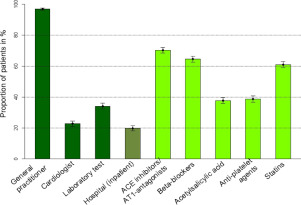当前位置:
X-MOL 学术
›
Int. J. Cardiol.
›
论文详情
Our official English website, www.x-mol.net, welcomes your
feedback! (Note: you will need to create a separate account there.)
Health care utilisation and medication one year after myocardial infarction in Germany - a claims data analysis.
International Journal of Cardiology ( IF 3.2 ) Pub Date : 2019-07-18 , DOI: 10.1016/j.ijcard.2019.07.050 Raven Ulrich 1 , Tobias Pischon 2 , Bernt-Peter Robra 3 , Christian Freier 1 , Christoph Heintze 1 , Wolfram J Herrmann 4
International Journal of Cardiology ( IF 3.2 ) Pub Date : 2019-07-18 , DOI: 10.1016/j.ijcard.2019.07.050 Raven Ulrich 1 , Tobias Pischon 2 , Bernt-Peter Robra 3 , Christian Freier 1 , Christoph Heintze 1 , Wolfram J Herrmann 4
Affiliation

|
BACKGROUND
After myocardial infarction, guidelines recommend pharmaceutical treatment with a combination of five different types of drugs for prevention in patients. However, studies from different countries have shown that this goal is not achieved in many patients. The aim of this study was to assess both healthcare and prescribed pharmaceutical treatment in the fourth quarter after index myocardial infarction.
METHODS
We conducted a claims data analysis with the data of patients who had had a myocardial infarction in the years 2013 or 2014, using information from the largest German health insurance fund ('AOK'). We analysed contact with physicians, hospital care and actual prescriptions for medication recommended in international guidelines, referring to beta-blockers, ACE inhibitors or angiotensin II receptor blockers, P2Y12-antiplatelet agents, acetylsalicylic acid and statins, one year after myocardial infarction. Analysis was stratified by age and sex, compared between patient groups and over time.
RESULTS
We identified 2352 patients who had survived myocardial infarction. Some 96.9% of these participants had at least one contact with their general practitioner (GP) one year after myocardial infarction, 22.8% contacted a cardiologist and 19.7% were hospitalised. Prescription rates range from 37.8% for acetylsalicylic acid to 70.4% for ACE inhibitors. However, only 24.1% received statins, beta-blockers, ACE inhibitors and an antiplatelet drug simultaneously. Prescription of recommended drugs after myocardial infarction decreased steadily over time.
DISCUSSION
Long-term medical prevention after myocardial infarction is improvable. GPs should take care of the pharmaceutical prevention after myocardial infarction as they are the physicians seen most intensively in this period.
中文翻译:

德国心肌梗死后一年的卫生保健利用率和药物治疗-索赔数据分析。
背景技术在心肌梗塞后,指南推荐药物治疗结合五种不同类型的药物来预防患者。但是,来自不同国家的研究表明,许多患者并未实现这一目标。这项研究的目的是评估指标性心肌梗死后第四季度的医疗保健和处方药物治疗。方法我们使用来自德国最大的健康保险基金('AOK')的信息,对2013年或2014年患有心肌梗死的患者的数据进行了理赔数据分析。我们分析了与医生的联系,医院护理和国际指南中推荐的药物实际处方,其中涉及β受体阻滞剂,ACEI抑制剂或血管紧张素II受体阻滞剂,P2Y12-抗血小板药,乙酰水杨酸和他汀类药物,在心肌梗塞后一年。根据年龄和性别对分析进行分层,并在患者组之间进行比较,并随时间推移进行比较。结果我们确定了2352例在心肌梗死中幸存的患者。这些参与者中约96.9%的人在心肌梗死后一年与他们的全科医生(GP)至少有过一次接触,22.8%的人与心脏病专家取得了联系,而19.7%的人则住院了。处方率范围从乙酰水杨酸的37.8%到ACE抑制剂的70.4%。但是,只有24.1%的人同时接受他汀类药物,β受体阻滞剂,ACEI抑制剂和抗血小板药物。心肌梗塞后推荐药物的处方随着时间的推移稳步下降。讨论改善心肌梗塞后的长期医学预防是可行的。
更新日期:2020-01-11
中文翻译:

德国心肌梗死后一年的卫生保健利用率和药物治疗-索赔数据分析。
背景技术在心肌梗塞后,指南推荐药物治疗结合五种不同类型的药物来预防患者。但是,来自不同国家的研究表明,许多患者并未实现这一目标。这项研究的目的是评估指标性心肌梗死后第四季度的医疗保健和处方药物治疗。方法我们使用来自德国最大的健康保险基金('AOK')的信息,对2013年或2014年患有心肌梗死的患者的数据进行了理赔数据分析。我们分析了与医生的联系,医院护理和国际指南中推荐的药物实际处方,其中涉及β受体阻滞剂,ACEI抑制剂或血管紧张素II受体阻滞剂,P2Y12-抗血小板药,乙酰水杨酸和他汀类药物,在心肌梗塞后一年。根据年龄和性别对分析进行分层,并在患者组之间进行比较,并随时间推移进行比较。结果我们确定了2352例在心肌梗死中幸存的患者。这些参与者中约96.9%的人在心肌梗死后一年与他们的全科医生(GP)至少有过一次接触,22.8%的人与心脏病专家取得了联系,而19.7%的人则住院了。处方率范围从乙酰水杨酸的37.8%到ACE抑制剂的70.4%。但是,只有24.1%的人同时接受他汀类药物,β受体阻滞剂,ACEI抑制剂和抗血小板药物。心肌梗塞后推荐药物的处方随着时间的推移稳步下降。讨论改善心肌梗塞后的长期医学预防是可行的。







































 京公网安备 11010802027423号
京公网安备 11010802027423号